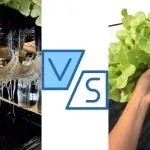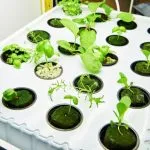Aeroponics is a fascinating and innovative method of growing plants without the need for soil. By suspending the plants’ roots in the air and providing them with nutrient-rich water mist, you can experience the many benefits of this advanced gardening technique. This method is highly efficient, using significantly less water and nutrients compared to traditional soil-based cultivation, and it often results in faster growth and higher yields for various types of plants.
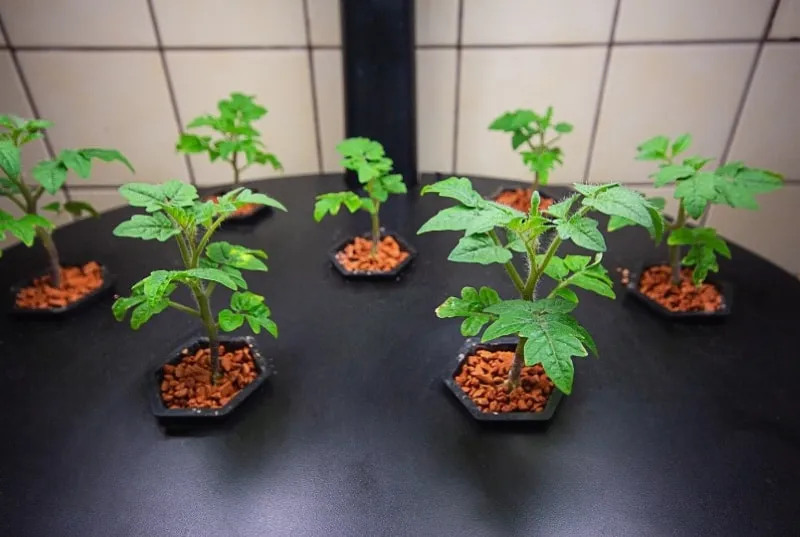
You might be curious about which plants thrive in aeroponic systems. So what can you grow with aeroponics? The good news is that a wide variety of fruits, vegetables, legumes, and more can be grown successfully in well-designed aeroponic setups, both indoors and outdoors. Nearly any plant can be grown using aeroponics, with vegetables like cucumbers being particularly well-suited due to their rapid growth rates and vining habit.
As you explore the world of aeroponics, keep in mind that the success of your garden depends on factors such as your setup, the nutrients you use, and careful system optimization. Our guide on how aeroponics works will make it clearer. With the right approach and dedication, your aeroponic garden can provide you with an abundance of fresh, healthy produce to enjoy in your daily life.
Best Plants for Aeroponics
Aeroponics is a versatile growing method that allows a wide range of plants, vegetables, and crops to thrive. In this section, you’ll find what we consider the best crops for aeroponics, including leafy greens, root crops, herbs, fruits, and legumes.
Leafy Greens
Leafy greens excel in aeroponic systems because they have shorter growing cycles and respond well to the nutrient-rich mist. Since nutrients are delivered directly to the root system in an aeroponic setup, the plants can focus more energy on producing leaves rather than roots.
They are sensitive to temperature shifts, so they do well in indoor aeroponic systems, making them an ideal choice. With a vertical aeroponic system, you can grow more leafy greens without consuming much space.
Some popular aeroponic leafy greens include:
- Lettuce: This versatile green can be grown in different varieties and is known for its high vitamin content and crisp, fresh flavor. Lettuce can be ready to harvest in just 30-45 days.
- Kale: With its high nutritional profile and distinctive taste, kale is a favorite among health-conscious growers. It can be harvested in about 55-60 days.
- Spinach: Spinach thrives in aeroponics due to its preference for a controlled environment, and it provides a rich source of vitamins and minerals. It can be harvested in 37-45 days.
Root Crops
When it comes to root crops, fennel, radishes, and carrots adapt well to aeroponic systems, offering you a delicious harvest of crisp vegetables with improved flavor compared to soil-grown counterparts. With some modifications tailored to accommodate their unique growth habits, you can be sure to provide enough room for them to develop their roots.
Aeroponics is a method that optimizes the oxygenation of the root zone, which is particularly beneficial for root crops like radishes and carrots. The roots grow freely in highly oxygenated mist rather than being submerged in soil or water, which can stimulate explosive growth. It often yields high-quality crops compared to traditional soil-based methods because nutrients can be delivered directly to the roots through nutrient-rich mist, providing optimal nourishment for growth.
These vegetables do not require a lot of lateral space to grow, making them well-suited for vertical farming techniques common in aeroponic systems.
A few examples are:
- Radishes and carrots: These require a more customized aeroponic setup, but their quick growth cycle makes them ideal for this method. Radishes can be harvested as quickly as three weeks after planting, whereas baby carrots can be harvested in about 50-60 days.
- Fennel bulb: The bulb fennel’s unique taste and culinary uses make it worth exploring in an aeroponic system. Fennel plants thrive in conditions that receive full sunlight, which can be easily controlled and maintained in an indoor aeroponic system.
Herbs
Herbs are a popular choice among aeroponic gardening enthusiasts because they are adaptable and often produce intense flavors when compared to growing in soil.
These herbs have fast growth rates, which can be further enhanced in an aeroponic system. They tend to grow in a bushy manner rather than deep roots or height, making them well-suited for the close quarters of an aeroponic system. Because these herbs can be harvested as soon as they reach maturity (and will continue to produce afterwards), they can provide a high yield even in small-scale home systems. You can use your aeroponic system to harvest fresh herbs indoors year-round.
A few examples are:
- Basil: This widely-used herb has a short growing cycle and delivers maximum flavor when grown aeroponically.
- Parsley: Fresh parsley provides a burst of flavor in various dishes, and, when grown aeroponically, it yields lush leaves and higher yields.
- Mint: Mint requires adequate light – typically 12-16 hours a day – which can be precisely controlled in an indoor aeroponic setup.
Related: Thinking of buying an aeroponic tower garden to grow these crops? We can help with your hunt. Take a look at these aeroponic tower garden reviews.
Fruits and Vegetables
Aeroponics offers an alternative growing method for fruits and vegetables, particularly when space is limited or vertical gardens are desired.
Certain fruits and vegetables generally produce high yields in aeroponic systems because they can grow vertically, which makes efficient use of space. The quality of these crops is often superior when grown using aeroponics because plants get exactly the nutrients they need when they need them. The continuous exposure to oxygen in an aeroponic system promotes healthy and vigorous plant growth. This results in healthier plants and tastier produce. Climate-controlled indoor aeroponic systems mean these crops can be cultivated year-round, regardless of outdoor weather conditions.
Some suitable aeroponic fruit and vegetable options include:
- Strawberries: The sweet taste and high yields of strawberries in aeroponic systems make them a popular choice, especially in tower gardens.
- Melons: Smaller varieties of melons, such as cantaloupe, can be grown in aeroponic systems with the appropriate support structures.
- Grape Tomatoes: The compact size of grape tomatoes makes them perfect for aeroponic growing, and they retain their intense flavor in this setting.
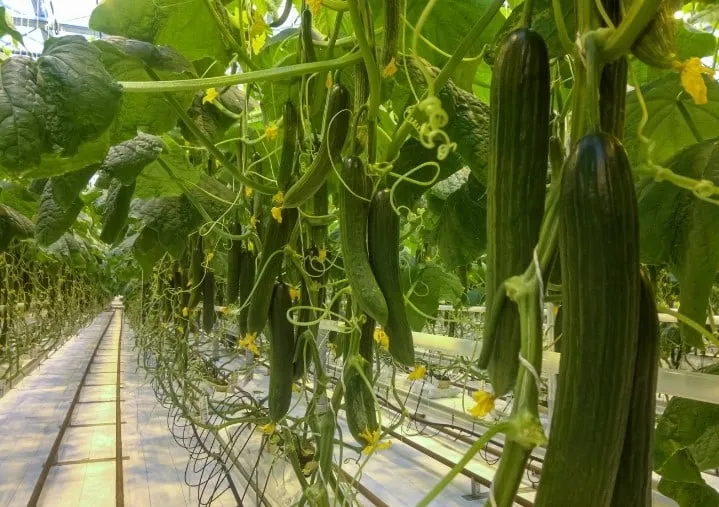
- Cucumbers: Both field cucumbers and smaller varieties, like pickling cucumbers, can be grown in aeroponic systems, provided sufficient vertical space is available.
- Pumpkins: Smaller pumpkin varieties like sugar pie or smaller gourds can be grown successfully in aeroponic systems.
- Brussels Sprouts: These nutrient-dense greens are challenging to grow in aeroponics, but with proper care, they produce high-quality sprouts.
- Bell Peppers: These plants are large and have a robust structure. An aeroponic system provides enough space and support for these plants to thrive. They usually stay on average for five months in an aeroponic system before they start producing harvestable fruits. This long growth cycle benefits from the controlled conditions provided by aeroponics. They are susceptible to several soil-borne diseases, so using an aeroponic system eliminates the risk of these diseases since there is no soil involved. As compared to certain other crops, bell peppers require less water and nutrients which make them well-suited for an aeroponics setup where fertilizer solution is used sparingly and water is conserved through recirculation.
- Legumes: Peas and beans quickly develop in an aeroponic system and are easy to harvest. Make sure to provide them with proper support to accommodate their climbing nature.
- Rice: Traditionally grown in flooded fields (paddy fields) but can adapt to this method because the nutrient solution can be adjusted to mimic the conditions rice naturally grows in. The key is to maintain optimal conditions like temperature, humidity, pH level of the nutrient solution, and light. The reason rice does well in aeroponics systems is because there’s greater control over plant nutrition and therefore potentially higher yields. There can be savings on water compared with traditional paddy field cultivation and there’s no need for pesticides or herbicides.
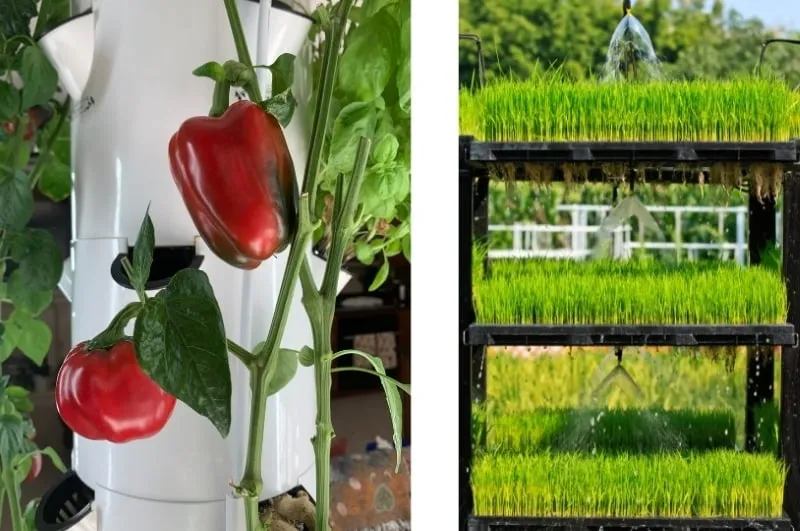
Remember to carefully research the specific needs of each plant if you’re transitioning to an aeroponic system, as it may require some adjustments to your setup or nutrient mix. Your plants will thank you with impressive yield and exceptional taste.
Related: Here is a thorough list of aeroponics advantages and disadvantages that affect growing of various crops.
If you’re wondering about aeroponics vs hydroponics yield, you’ll generally get more per square foot from aeroponics.
Caring for Your Plants Grown In Aeroponics
Aeroponics allows you to grow a wide variety of plants with increased growth rates and healthy plant roots. To ensure successful growth and a bountiful harvest, you’ll want to follow these steps when caring for your plants.
First, it’s essential to provide your plants with a balanced mixture of water, nutrients, and oxygen. Regularly check your nutrient reservoir to make sure it maintains an appropriate water level and the concentration of nutrients and dissolved oxygen. You can typically find premixed nutrient solutions designed specifically for aeroponic systems.
Next, carefully monitor your water pump and misters, as they play a vital role in supplying your plants with water and nutrients. Make sure your pump and misters are functioning correctly and not clogged, as this could cause stress on your plants and lead to poor growth or, worse, root rot.
Timers play a critical role in aeroponic systems. You’ll want to set your timer to regulate the frequency of nutrient misting. This may vary depending on the type and size of your plants, so it’s helpful to experiment with different settings until you achieve optimal growth.
When starting with seedlings, make sure they’re strong enough to support themselves before placing them in your aeroponic system. Once they’re ready, secure them using support collars and place them in net pots or a platform with holes.
As your plants grow, they may require additional support, such as a trellis for vining plants like cucumbers. Having enough vertical space for your plants to grow is crucial, so make sure to plan for this when setting up your system — both indoors and outdoors.
Regular pruning of your plants will contribute to better growth and higher yields. By removing excess foliage, you allow more light to reach the lower leaves and reduce the chance of pest infestations or diseases.
In summary, by keeping your aeroponic system well-maintained and providing appropriate care, you can enjoy a successful planting experience with excellent growth and a bountiful harvest.
What Can You Not Grow With Aeroponics?
While aeroponics is an efficient and space-saving method for growing many types of plants, there are a few plants that might not thrive or be well-suited for this system.
One of the main challenges with aeroponics is the need for constant monitoring of nutrient and water levels. Some plants have higher nutrient demands and would require more frequent adjustments, making them less ideal for aeroponic systems.
While many plants can flourish in an aeroponic system, there are a few that typically don’t perform as well. These include:
- Woody Plants: Woody plants like trees and shrubs generally struggle to grow in aeroponic systems due to their extensive root systems and need for strong anchorage.
- Tubers and Bulbs: Some types of tuberous and bulbous plants may not do well in aeroponic setups since they have large and bulky root systems. These plants need sufficient space and soil for their roots to grow, which is contrary to the nature of aeroponics.
- Plants with Deep Root Systems: Similarly, any plant species that have deep or wide-spreading root systems may not be suited to the confines of an aeroponic system.
- Large melons, pumpkins, or squash: These plants typically have a complex root system, which helps them anchor in the ground and allows for added support to hold the weight of the growing fruit. Aeroponic systems might not provide the necessary stability and structure these plants need for proper growth and support.
- Corn and other tall or heavy plants: Due to their height and weight, they might require extra support that’s difficult to provide in an aeroponic setup. Also, wind pollination is crucial for plants like corn, which might be difficult to achieve indoors or in an enclosed space.




